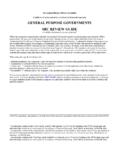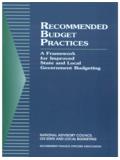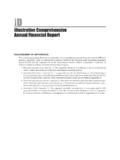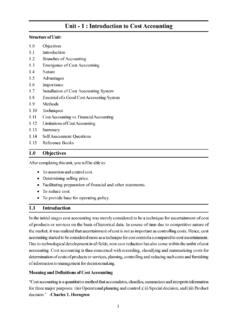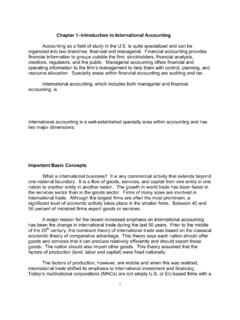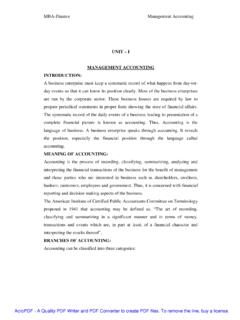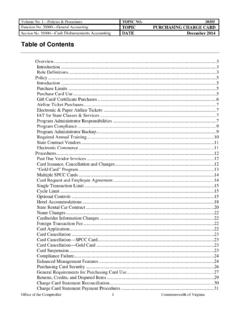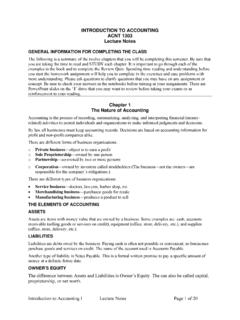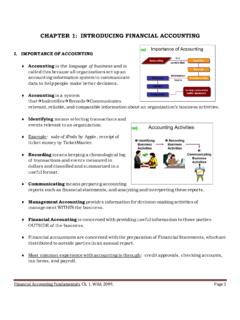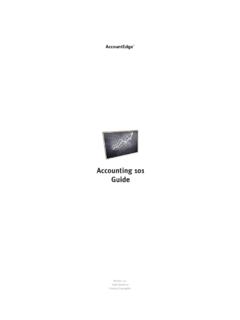Transcription of b Back to Basics An Overview of Governmental …
1 48 Government Finance Review | February 2013 Everyone involved in overseeing or managing government operations needs to understand the Basics of public-sector accounting and financial those involved in the over-sight or management of gov-ernment operations, and those whose livelihoods and interests rely on the finances of state and local govern-ments, need to have a clear understand-ing of Governmental accounting , audit-ing, and financial reporting , which are based on a sound set of principles and interrelated practices and procedures.
2 ACCOUNTINGThe term accounting is used to describe the process of assembling, analyzing, classifying and recording data that is relevant to transactions and events affecting the government s finances. Assembling involves gathering togeth-er purchase orders, invoices, billing statements, notices, receipts, receiving slips, closing documents, bank state-ments, correspondence, and other documents that support a transaction. These documents must then be ana-lyzed so someone unfamiliar with the transaction can understand who and what was involved; when, where and why the transaction or event took place; and the value to be assigned to a comprehensive chart of accounts, the government can then properly classify the components of the transaction or event and, finally, record it as journal entries.
3 The effect on each account, in turn, is then posted to the general ledger, which contains a list of balances for each of the accounts found in the chart of reporting accounting and financial report-ing are similar but distinctly differ-ent terms that are often used togeth-er. financial reporting is the process of aggregating and summarizing the detailed information that was assem-bled, analyzed, classified, and recorded in the accounting process, and putting it into a usable form for decision mak-ing by those who need reporting can take one of three forms: internal financial report-ing, special-purpose external financial reporting , and general-purpose external financial reporting .
4 Internal financial reporting is developed for management to meet specific managerial needs and preferences, with management deter-mining the content, format, and timing of the reports. Special purpose external be s t Pr a c t i c e sBack to Basics An Overview of Governmental accounting and financial ReportingBy Michael GenitoAccountingAssembling(source documents)AnalyzingClassifyingRecording( journal entries)February 2013 | Government Finance Review 49financial reporting is developed for the use of those outside the government to meet certain legal or contractual requirements, such as state regulatory agency or grantor purpose external financial reporting is developed for those who rely on the information contained in the reports and do not have direct access to the jurisdiction s financial information.
5 General purpose external financial reporting typically is governed by generally accepted accounting prin-ciples. Three communications meth-ods1 are used to present information in general purpose external financial reporting : display, disclosure, and sup-porting The display method of communication provides that items are reported as dollar amounts on the face of the financial statements if they both 1) meet the definition of one of the seven financial statement elements and 2) can be reliably measured.
6 The seven financial statement elements for state and local governments are assets, liabilities, inflows of resources, out-flows of resources, deferred inflows of resources, deferred outflows of resourc-es, and net Assets are resources with present ser-vice capacity that the government pres-ently controls, meaning that the gov-ernment is able to use the resource s present service capacity and to deter-mine the nature and manner of its use. Control does not have to be absolute, and is usually associated with either legal ownership or contractual rights.
7 Control must also result from some past event, not an inherent are present obligations to sacrifice resources that the government has little or no discretion to avoid, usu-ally because it is legally enforceable, based on a contract or third-party leg-islation. Liabilities must involve a party external to the government. A construc-tive ( , inferred) liability may need to be recognized if social, moral, or economic consequences leave the gov-ernment little or no discretion to avoid sacrificing the resources. Commitments (such as the provision of public educa-tion) are not of resources are the govern-ment s acquisition of net assets that is applicable to the reporting peri-od.
8 Acquisition involves either new resources coming under the govern-ment s control or resources already under the government s control becom-ing newly available, resulting in either a net increase in assets or a net decrease in liabilities. Outflows of resources are the government s consumption of net assets that is applicable to a reporting period. Consumption involves consum-ing (using up) an existing resource or consuming a resource as it is acquired, resulting in either a net decrease in assets or a net increase in liabilities.
9 Deferred inflows of resources are the government s acquisition of net assets (inflows of resources) that is applicable to a future reporting period (deferred). Deferred outflows of resources are the government s consumption of net assets (outflows of resources) that is applicable to a future reporting period (deferred).Net position is the residual of all other elements presented in a statement of financial position. The Governmental accounting version of the accounting equation can be defined as (assets + deferred outflows of resources) - (lia-bilities + deferred inflows of resources) = net The disclosure meth-od of communication includes three types of information that are properly included within the notes to the finan-cial statements: 1) descriptions of the policy underlying amounts presented in the financial statements.
10 2) detail or financial ReportingFinancial Users Access to Content, Format, Report Information and TimingInternal Management Yes ManagementSpecial Grantors, Yes Third parties Purpose Certain Creditors, External Government Agencies General Public No GAAPG eneral Purpose External financial reporting Communication MethodsDisplayDisclosureSupporting InformationGovernmental accounting EquationAssets+ Deferred Outflows of Resources- Liabilities- Deferred Inflows of Resources= Net Position 50 Government Finance Review | February 2013explanations concerning amounts pre-sented in the financial statements.



